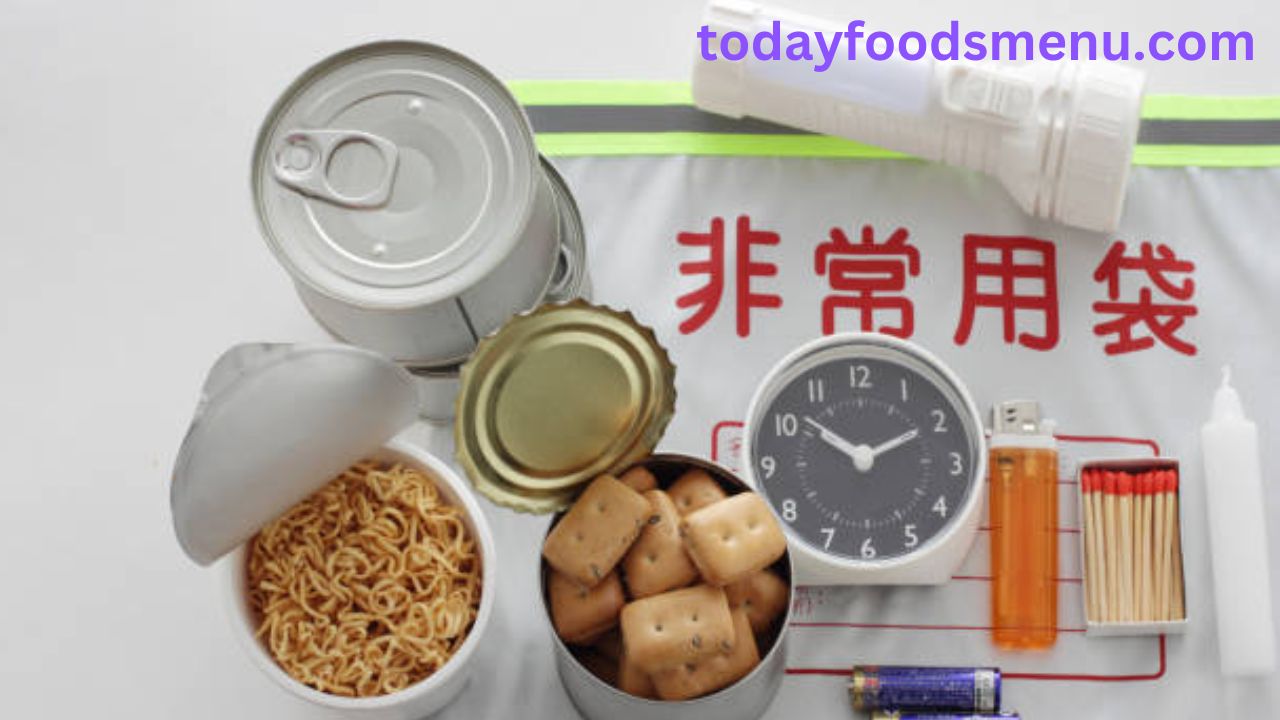Introduction
Having access to emergency food can significantly improve your and your family’s well-being in times of crisis. Preparing the right food supplies is crucial when facing natural disasters, economic downturns, or other unforeseen events. This article will delve into the importance of emergency food, the types of emergency food supplies, storage tips, creating your emergency food kit, and much more.
The Importance of Emergency Food
Why Prepare for Emergencies?
Emergencies can occur at any time and frequently do so without notice. Natural disasters, such as hurricanes, earthquakes, wildfires, and floods, can disrupt everyday life and access to food. Similarly, economic issues—such as job loss, inflation, or supply chain disruptions—can make food more challenging to obtain.
Natural Disasters
Natural disasters can lead to power outages, damaged roads, and food shortages. In such situations, having emergency food supplies can ensure you have enough to eat until help arrives or conditions improve.
Economic Issues
Economic downturns can cause sudden changes in your financial situation, making it challenging to afford groceries. An emergency food stockpile can relieve and prevent food insecurity in these cases.
Food Security
The ability to consistently obtain sufficient, reasonably priced, and healthful food is known as food security. During emergencies, food insecurity can rise sharply. Stocking up on emergfood helps ensure you and your family have enough to eat, even when everyday food supplies are unavailable.
Peace of Mind
Knowing you have a supply of emergency food can provide peace of mind. During stressful times, you won’t have to worry about where your next meal will come from. This allows you to focus on other essential tasks, such as ensuring your family’s safety and seeking necessary assistance.
Types of Emergency Food Supplies
Non-Perishable Foods
Non-perishable foods are ideal for emergencies because they do not spoil quickly and can be stored for long periods. Some common types include:
Canned Goods
- Vegetables: Canned vegetables are versatile and can be added to various meals.
- Fruits: Canned fruits can provide essential vitamins and make a great snack or dessert.
- Meats: Canned meats (like chicken, tuna, or beef) are excellent protein sources and can be used in numerous recipes.
Shelf Life: Most canned goods have a shelf life of 2-5 years.Keep an eye out for expiration dates and rotate your inventory..
Dry Grains
- Rice: A staple food that is filling and versatile. White rice can last up to 30 years if stored properly, while brown rice has a shorter shelf life of about six months to 1 year.
- Quinoa: This grain is high in protein and can be a nutritious addition to your emergency food supply.
- Pasta: A favorite for many families, pasta is easy to prepare and has a long shelf life of 2-3 years.
Dried Beans
Dried beans are rich in protein, fiber, and essential nutrients. If stored correctly, they can last indefinitely, making them an excellent addition to your emergency food supply.
Preparation: Dried beans must be soaked and cooked before consumption, which requires water and time, but they can be very filling and nutritious.
Freeze-Dried Foods
Freeze-dried foods retain most of their nutrients and can be stored longer. They are lightweight and easy to prepare, making them perfect for emergency kits. Many freeze-dried meals only require water to cook.
Benefits of Freeze-Dried Foods
- Long Shelf Life: Freeze-dried foods can last 25 years or more when stored in a cool, dry place.
- Nutrient Retention: The freeze-drying process preserves the food’s nutritional value and flavor.
- Convenience: Just add water, and meals can be ready in minutes.
Ready-to-Eat Meals
Ready-to-eat meals (MREs) are designed for convenience. All they need to do is reheat as they are already fully cooked. The military often uses these meals, which are perfect for emergencies because they require no cooking.

Components of MREs
MREs typically include:
- A main entrée (e.g., beef stew, chicken with rice)
- Side items (e.g., crackers, cheese spread)
- A dessert (e.g., cookies, pound cake)
- Utensils and napkins
Shelf Life: MREs can last 12-24 months if stored at room temperature.
Nutritional Bars and Snacks
Nutritional bars and snacks are compact and provide quick energy. They are a great addition to any emergency food kit because they are easy to store and consume.
Types of Nutritional Bars
- Granola Bars are often fiber-rich and can be a quick energy boost.
- Protein Bars: High in protein, these can help keep you full longer.
- Energy Bars: Specifically designed for endurance, these bars can be particularly useful in emergencies.
How to Build Your Emergency Food Kit
Assess Your Needs
Before building your emergency food kit, consider your family’s specific needs. Factors to consider include:
- Number of People: Calculate how many people are in your household and how much food each person will need.
- Dietary Restrictions: Be mindful of allergies or dietary preferences (e.g., vegetarian, gluten-free).
- Age Considerations: Young children, elderly family members, and pets may require special foods or supplies.
Choose Foods Wisely
Select foods that your family enjoys, and that are easy to prepare. Having a variety of foods is essential to prevent boredom and ensure proper nutrition.
Recommended Food Categories
- Staples: Grains, pasta, rice
- Proteins: Canned meats, dried beans, nuts
- Fruits and Vegetables: Canned or freeze-dried options
- Snacks: Granola bars, trail mix, dried fruits
Calculate Quantities
A good rule of thumb is to have enough food for at least three days for each person in your household. Consider adding extra supplies if you live in an area prone to disasters.
Storage Tips for Emergency Food
Find the Right Location
keep your emergency food in a cool, dry place. Heat and moisture can spoil food quickly. Ideal locations include:
- Basements: Generally cool and dark, making them perfect for long-term storage.
- Pantries: Ensure they are well-ventilated and away from heat sources.
- Closets: Can be used for overflow supplies.
Use Airtight Containers
For added protection, consider using airtight containers for dry foods. This helps keep moisture and pests out. Good options include:
- Glass Jars: Great for bulk grains and dried beans.
- Plastic Bins: Stackable and can hold a large quantity of items.
- Vacuum-Sealed Bags: Ideal for preserving the freshness of grains and snacks.
Regularly Check Expiration Dates
Periodically check the expiration dates on your emergency food supplies. Replace any items nearing expiration to ensure your stock is always fresh and ready for use.
Creating a Checking Schedule
- Every 6 Months: Conduct a thorough inventory of your supplies.
- After Major Purchases: Check items that were added recently to ensure freshness.
Rotate Your Stock
Practice the “first in, first out” method. When you buy new food supplies, place them behind older items. This ensures you use the older items first, reducing waste and maintaining a fresh supply.

Creating a Balanced Emergency Food Supply
Incorporate a Variety of Foods
A balanced emergency food supply should include a variety of food groups, including grains, proteins, fruits, and vegetables. Variety ensures you get the necessary nutrients to maintain your health during an emergency.
Suggested Combinations
- Breakfast: Oatmeal, dried fruits, and nuts.
- Lunch: Canned soup, crackers, and a piece of fruit.
- Dinner: Pasta with canned sauce and canned vegetables.
Consider Special Dietary Needs
If anyone in your household has special dietary requirements, include appropriate foods. This may consist of gluten-free options, low-sodium foods, or specific types of protein.
Examples of Special Needs
- Gluten-Free: Quinoa, rice, and gluten-free pasta.
- Low-Sodium: Look for low-sodium canned goods and foods.
- Diabetic-Friendly: Incorporate foods with low sugar content.
Emergency Food Preparation
Cooking Methods
Consider various cooking methods when preparing emergency food. Familiarity with different techniques can help you efficiently use your food supply during an emergency.
Common Cooking Methods
- Boiling: Ideal for pasta, grains, and some canned foods.
- Baking: Use for bread mixes or any dishes that can be assembled and cooked in an oven.
- Using a Camp Stove is a portable cooking option that is useful if the power is out. Ensure you have the necessary fuel.
Practice Cooking
If you rely on certain meals during emergencies, practice cooking them beforehand. This will help you feel more confident in preparing food under stress.
Recipe Ideas
- Rice and Beans: A staple dish that is easy to prepare and provides a good mix of carbohydrates and protein.
- Pasta Primavera: Use freeze-dried vegetables and pasta for a nutritious meal.
- Soup from Canned Goods: Mix various canned vegetables and proteins with broth for a hearty meal.
Emergency Food and Nutrition
Importance of Nutrients
During an emergency, it’s vital to maintain a balanced diet. Aim for a mix of carbohydrates, proteins, and healthy fats. This balance helps keep energy levels up and supports overall health.
Essential Nutrients
- Carbohydrates: Provide energy. Give priority to fruits, vegetables, and entire grains.
- Proteins: Important for muscle health. Include beans, canned meats, and nut butter.
- Fats: Healthy fats from olive oil, nuts, and avocados can provide essential nutrients.
Understanding Food Labels
Reading food labels can help you understand the nutritional content of your store items. Pay attention to serving sizes, calories, and critical nutrients.
Key Label Terms
- Serving Size: It is essential to understand how many servings are in a package.
- Calories: Provides insight into the energy content of the food.
- Nutritional Information: Look for items high in nutrients and low in added sugars or sodium.
Supplements
Consider including vitamins or supplements in your emergency food kit. These can help fill nutritional gaps in your food supply, especially if fresh produce is unavailable.
Types of Supplements
- Multivitamins: Provide a broad range of essential nutrients.
- Electrolyte Packs: Helpful for maintaining hydration.
- Protein Powders: Can be mixed with water or milk to supplement protein intake.

Conclusion
Emergency food preparation is essential for ensuring your family’s safety and well-being during crises. You can be better prepared by understanding the types of emergency food, how to build a food kit, storage tips, and nutritional considerations. Remember to assess your family’s needs, maintain a balanced diet, and stay informed about community resources.


